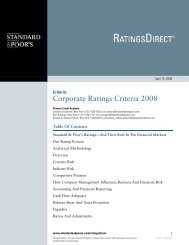European Infrastructure Finance Yearbook - Investing In Bonds ...
European Infrastructure Finance Yearbook - Investing In Bonds ...
European Infrastructure Finance Yearbook - Investing In Bonds ...
Create successful ePaper yourself
Turn your PDF publications into a flip-book with our unique Google optimized e-Paper software.
UTILITIES<br />
34 ■ NOVEMBER 2007<br />
their respective governments’ national allocation<br />
plans (NAPs). These plans are vetted and<br />
approved by the EU. Allowances for Phase 1 are<br />
already known, while Phase 2 allowances are<br />
currently being finalized. Even though a generator<br />
will have received free allowances to cover its<br />
carbon emissions, it will still price emission costs<br />
as if it had purchased the allowances from the<br />
market, leading to higher wholesale prices. For<br />
many generators, these higher wholesale prices<br />
drop directly to the bottom line as windfall<br />
profits, either because the allowance was never<br />
purchased or because the generator (nuclear and<br />
hydro plants, for example) does not emit<br />
greenhouse gases. Companies currently benefiting<br />
from windfall profits are those operating in the<br />
U.K., German, and Nordic electricity markets,<br />
and include E.ON AG (AA-/Watch Neg/A-1+),<br />
RWE AG (A+/Negative/A-1), EnBW Energie<br />
Baden-Wuerttemberg AG (A-/Stable/A-2),<br />
Vattenfall AB (A-/Stable/A-2), Scottish and<br />
Southern Energy PLC (A+/Stable/A-1), Scottish<br />
Power PLC (A-/Watch Neg/A-2), and EDF Energy<br />
PLC (A/Stable/A-1).<br />
Approved NAPs indicate a tighter market in<br />
Phase 2 of the ETS<br />
The <strong>European</strong> Commission has now decided on<br />
the first 20 national plans for allocating CO2<br />
emission allowances to energy-intensive industrial<br />
plants and the power sector for Phase 2 of the<br />
ETS (see table on next page). Seventeen of the 20<br />
member states were told to reduce proposed<br />
allowances by almost 12.5% on average, while<br />
allowances for the U.K., France, and Slovenia<br />
were approved as presented (the adjustment to<br />
Spain’s proposed cap was negligible). To date, the<br />
overall cap allowed by the EU for Phase 2 is<br />
about 9% lower than the cap allowed for Phase 1.<br />
It is likely the electricity generation companies<br />
will take a significant share of this tightening<br />
through a lower allocation of free allowances in<br />
Phase 2. From an equity standpoint, the electricity<br />
generation companies may be best positioned to<br />
absorb a lower level of allowances given that they<br />
benefit from higher CO2-induced power prices<br />
while industrial and residential power users bear<br />
the cost.<br />
The tightening in Phase 2 could lead to stronger<br />
CO2 and power prices, albeit that the precise<br />
impact and direction for prices depends on a large<br />
number of other factors such as the generation<br />
STANDARD & POOR’S EUROPEAN INFRASTRUCTURE FINANCE YEARBOOK<br />
mix, oil and gas prices, and demand. This<br />
highlights the EU’s continuing commitment to<br />
cutting greenhouse gas emissions, and to meeting<br />
targets under the Kyoto Protocol.<br />
Windfall profits will diminish as free allowances<br />
go down<br />
Under Phase 1 of the ETS, free allowances<br />
covered a very significant share of generators’<br />
actual and forecast CO2 emissions. Despite an<br />
expected reduction of free allowances granted to<br />
generators in Phase 2, we expect the windfall<br />
profits generated in liberalized energy markets-such<br />
as the U.K., Germany, and the Nordic<br />
market--to continue, albeit to a lesser extent,<br />
reflecting a pricing strategy based on the marginal<br />
cost of generation (i.e. including emissions costs).<br />
The windfall benefit remains controversial<br />
because it applies not only to nonemitting<br />
facilities but to all--including coal plants, which<br />
emit the most GHGs. Many industrial end users<br />
have voiced their discontent. They maintain that<br />
while end users suffer from the higher cost of<br />
electricity due to the cost of CO2 emissions, the<br />
electricity generators--those actually releasing<br />
much of the CO2--are gaining incremental profits.<br />
As a result, Standard & Poor’s expects that the<br />
level of free emission allowances granted to fossil<br />
fuel-fired generators may continue to go down in<br />
future phases of the ETS (2012 and beyond).<br />
These generators will therefore either have to buy<br />
a greater proportion of their carbon allowances in<br />
the market or actually reduce CO2 emissions.<br />
They could cut their carbon output by switching<br />
generation from coal-fired to less CO2-intensive<br />
gas-fired generation, improving the efficiency of<br />
their coal plants, or by using carbon capture and<br />
sequestration (CCS) storage technology.<br />
Climate Change Policies Present<br />
<strong>In</strong>vestment Challenges<br />
<strong>In</strong> addition to its focus on slowing climate change,<br />
the EU is also trying to increase competition in<br />
the power sector and to reduce dependence on<br />
imported gas, two goals that it believes are<br />
compatible. EU climate change and market<br />
liberalization policies have to date favored gas<br />
and--to a much lesser extent--wind power in the<br />
generation mix at the expense of coal, as wind<br />
and gas are cleaner than coal and it takes less<br />
time to build a gas plant than it does to build a<br />
coal plant, an important factor in liberalized



